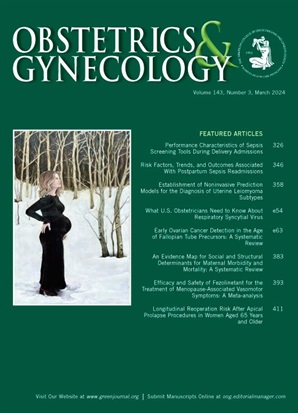Conversion Rate for Robotic-Assisted Gynecologic Cancer Surgery.
IF 4.7
2区 医学
Q1 OBSTETRICS & GYNECOLOGY
引用次数: 0
Abstract
Our objective was to identify the rate of and reasons for conversion from robotic-assisted surgery to laparotomy for patients with gynecologic cancers. A retrospective analysis was conducted of all consecutive robotic surgeries for gynecologic cancers performed at a tertiary cancer center between December 2007 and December 2022. Data were stratified based on cancer type (endometrial, ovarian, cervical, and "other") and body mass index (BMI). Reasons for conversion were categorized as specimen removal, anesthesia-related, organ or vessel injury, advanced metastatic disease, and equipment malfunction. The conversion rate was 2.4% (55/2,328) overall and 0.5% for endometrial cancer after excluding mini-laparotomies performed solely to remove large specimens. The predominant reason for conversion in ovarian cancer was disease invasion into surrounding structures not amenable to robotic resection. No association was found between conversion rates and BMI or age.机器人辅助妇科癌症手术的转换率。
我们的目的是确定妇科癌症患者从机器人辅助手术转向剖腹手术的比率和原因。回顾性分析了2007年12月至2022年12月在三级癌症中心连续进行的妇科癌症机器人手术。根据癌症类型(子宫内膜癌、卵巢癌、宫颈癌和“其他”)和体重指数(BMI)对数据进行分层。转换的原因分为标本切除、麻醉相关、器官或血管损伤、晚期转移性疾病和设备故障。排除单纯切除大标本的小剖腹手术后,总体转化率为2.4%(55/ 2328),子宫内膜癌的转化率为0.5%。卵巢癌转化的主要原因是疾病侵入周围结构,不适合机器人切除。转化率与BMI或年龄之间没有关联。
本文章由计算机程序翻译,如有差异,请以英文原文为准。
求助全文
约1分钟内获得全文
求助全文
来源期刊

Obstetrics and gynecology
医学-妇产科学
CiteScore
11.10
自引率
4.20%
发文量
867
审稿时长
1 months
期刊介绍:
"Obstetrics & Gynecology," affectionately known as "The Green Journal," is the official publication of the American College of Obstetricians and Gynecologists (ACOG). Since its inception in 1953, the journal has been dedicated to advancing the clinical practice of obstetrics and gynecology, as well as related fields. The journal's mission is to promote excellence in these areas by publishing a diverse range of articles that cover translational and clinical topics.
"Obstetrics & Gynecology" provides a platform for the dissemination of evidence-based research, clinical guidelines, and expert opinions that are essential for the continuous improvement of women's health care. The journal's content is designed to inform and educate obstetricians, gynecologists, and other healthcare professionals, ensuring that they stay abreast of the latest developments and best practices in their field.
 求助内容:
求助内容: 应助结果提醒方式:
应助结果提醒方式:


